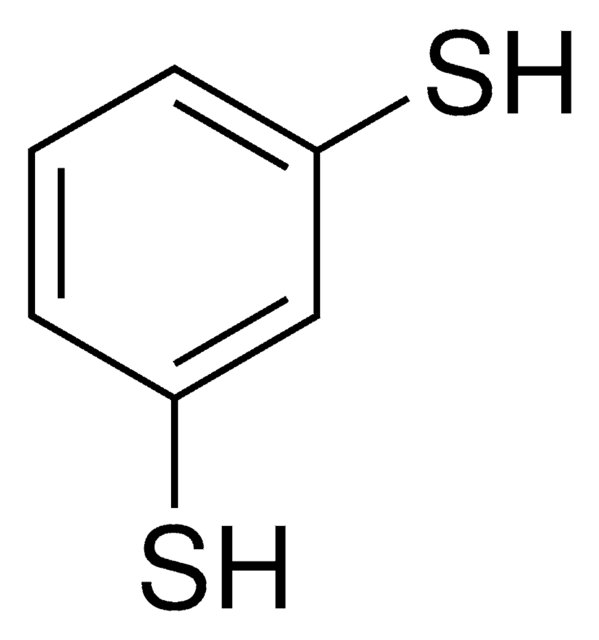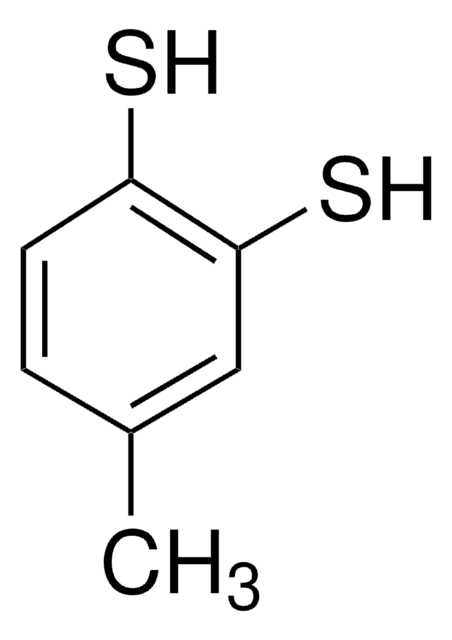763969
Benzene-1,4-dithiol
99% (GC)
Synonyme(s) :
1,4-Benzenedithiol, 1,4-Dimercaptobenzene
Se connecterpour consulter vos tarifs contractuels et ceux de votre entreprise/organisme
About This Item
Formule empirique (notation de Hill):
C6H6S2
Numéro CAS:
Poids moléculaire :
142.24
Numéro MDL:
Code UNSPSC :
12352103
ID de substance PubChem :
Nomenclature NACRES :
NA.23
Produits recommandés
Niveau de qualité
Pureté
99% (GC)
Forme
powder or crystals
Pf
92-97 °C
Température de stockage
2-8°C
Chaîne SMILES
Sc1ccc(S)cc1
InChI
1S/C6H6S2/c7-5-1-2-6(8)4-3-5/h1-4,7-8H
Clé InChI
WYLQRHZSKIDFEP-UHFFFAOYSA-N
Description générale
Benzene-1,4-dithiol (BDT) is a class of aromatic dithiol that can be used to form a self-assembled monolayer (SAM) on a variety of surfaces.
Application
BDT can be used as a cross-linker that facilitates the development of acrylate based light sensitive epoxidized soya bean oil for 3D printing applications. Gold based nanoconstrictions can be fabricated by functionalizing the surface with BDT, which reduces the overall flicker noise with respect to the unmodified surface.
This molecule can be used in single molecule junctions in electronic devices. It has also shown use in nanomaterial synthesis.
Code de la classe de stockage
11 - Combustible Solids
Classe de danger pour l'eau (WGK)
WGK 3
Point d'éclair (°F)
Not applicable
Point d'éclair (°C)
Not applicable
Faites votre choix parmi les versions les plus récentes :
Déjà en possession de ce produit ?
Retrouvez la documentation relative aux produits que vous avez récemment achetés dans la Bibliothèque de documents.
Les clients ont également consulté
Xing; et al.
Journal of the American Chemical Society, 132, 7946-7946 (2011)
Li Lin et al.
ACS nano, 12(7), 6492-6503 (2018-06-21)
Charge transport plays an important role in defining both far-field and near-field optical response of a plasmonic nanostructure with an ultrasmall built-in nanogap. As the gap size of a gold core-shell nanomatryoshka approaches the sub-nanometer length scale, charge transport may
Photoresins based on acrylated epoxidized soybean oil and benzenedithiols for optical 3D printing
Miezinyte G, et al.
Rapid Prototyping Journal (2018)
Conductance of a molecular junction
Reed MA, et al.
Science, 278(5336), 252-254 (1997)
Yung-Ching Chang et al.
Optics express, 25(20), 24767-24779 (2017-10-19)
Near-field and far-field optical properties of plasmonic materials can be tailored by coupling the existing structures. However, fabricating 3D coupled structures in the solution by molecular linkers may suffer from low yield, low stability (particle aggregates), long reaction time, complex
Notre équipe de scientifiques dispose d'une expérience dans tous les secteurs de la recherche, notamment en sciences de la vie, science des matériaux, synthèse chimique, chromatographie, analyse et dans de nombreux autres domaines..
Contacter notre Service technique











